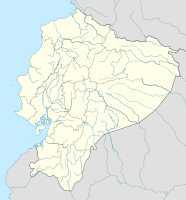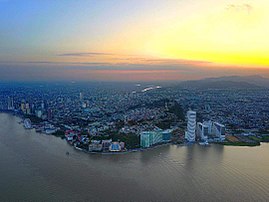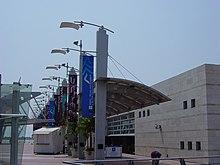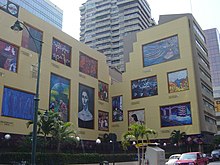Guayaquil
| Guayaquil | ||
|---|---|---|
|
Coordinates: 2 ° 11 ′ S , 79 ° 53 ′ W Guayaquil on the map of Ecuador
|
||
| Basic data | ||
| Country | Ecuador | |
| province | Guayas | |
| City foundation | after 1534 | |
| Residents | 2,644,891 (2017) | |
| - in the metropolitan area | 3.3 million | |
| City insignia | ||
| Detailed data | ||
| surface | 344.5 | |
| Population density | 7677 inhabitants / km 2 | |
| height | 5 m | |
| City structure | 16 municipalities (+ 5 rural in the canton) |
|
| Waters | Río Guayas , Río Daule | |
| Post Code | 090101-090158 | |
| prefix | (+593) 4 | |
| License Plate | Gxx | |
| Time zone | UTC -5 | |
| City Presidency | Cynthia Viteri ( PSC ) | |
| City patron | James the Elder ( Santiago ) | |
| Website | ||
| Aerial view of Guayaquil | ||
| Center of Guayaquil | ||
Guayaquil (actually Santiago de Guayaquil ) is the capital of the Ecuadorian province of Guayas , has the most important port of Ecuador and is next to the capital Quito one of the two largest cities of Ecuador.
Guayaquil has about 2.65 million inhabitants (as of 2017), more than 3 million people live in the greater Guayaquil area.
geography
Guayaquil is located on the west bank of the Río Guayas , about 50 km above its confluence with the Gulf of Guayaquil . The Río Guayas is a confluence of the Río Daule and the Río Babahoyo in Guayaquil . The original center of Guayaquil is located at a low altitude between three hills and the Estero Salado ( Spanish for "salty swamp"), an inland arm of the sea, which in today's urban area partly dried up and u. a. has been built on with upscale residential areas.
The climate in Guayaquil is tropical, so humid and hot. The year is divided into a dry and a rainy season ("winter"). The latter lasts from around January to June. The annual average temperature is 24.9 ° C, the average rainfall is 843 millimeters per year.
|
Average monthly temperatures and rainfall for Guayaquil
Source: wetterkontor.de
|
||||||||||||||||||||||||||||||||||||||||||||||||||||||||||||||||||||||||||||||||||||||||||||||||||||||||||||||||||||||||||||||||||||||||||||||||||||||||||||||||||||||||||||||||||||||||||||||||||||||||||||||||||||||||||||||||||||||||||||||||||||
history
Founding history
The founding history of Guayaquil is uncertain, as is the origin of the name. A city called Santiago (de Quito) was first founded by Diego de Almagro and Sebastián de Benalcázar as a starting point for advances to the Pacific coast in 1534 , but on Lake Colta near today's Riobamba . Since its location did not meet the requirements of the Conquista , it was gradually moved to the coast. It was destroyed several times by local fighters of the Chola, Chone , Puná and Huancavilca Indians.
Until 1542 the post appears in documents as Santiago de la Culata , since the settlement areas of the Huancavilca were designated as Provincia de la Culata by the administration in Quito (since 1539/40) . Since December 1542, the name Guayaquil has appeared repeatedly as an area designation and seems to be slowly gaining acceptance with the increasing "familiarization" of the Spaniards with the inhabitants of the region.
According to legend, the name Guayaquil refers to a legendary chief of the Puruhá Indians named Guayas and his wife Quill , who came from the highlands and who , according to legend, killed himself before he drowned so as not to fall into the hands of the Spaniards. However, Guayaquil was probably the name of a place and its chief and Quill / Kil a spring goddess or the name of water-rich areas. The legend of Guayas and Quill can thus be interpreted as an allegory of the fall of the Huancavilca Indians. However, there are other linguistic explanations according to which Guayaquil means "our big house" in Tsafiki, the pre-Inca language of today's Tsáchila .
The first Santiago de Guayaquil , founded around 1542/3, was relocated again by troops loyal to the king after the rise of Gonzalo Pizarro against viceroy Blasco Núñez Vela (since 1544). On July 25, 1547, the city is said to have been founded for the last time at its current location by the captains Francisco de Olmos , Rodrigo Vargas de Guzmán and Toribio de Castro. July 25th is the day of remembrance of the apostle James (Spanish: Santiago ) in the Catholic Church .
According to other, not necessarily contradicting information, Francisco de Orellana is considered to be the founder of Guayaquil. This information probably refers to a foundation given for 1537 or 1538 by one of the predecessors of today's Guayaquil.
Colonial times
During the colonial period, Guayaquil soon became an important port city of the Viceroyalty of Peru and later New Granada , via which on the one hand the products of the coastal region (wood, later also cocoa and peanuts ) were transported and on the other hand products from other colonies and from Spain landed. Its geographical location halfway between Lima and Central America reinforced its importance as did the inland river system. Guayaquil developed into one of the most important shipyard locations in South America.
Due to its exposed location, Guayaquil was attacked and looted several times by pirates and privateers in the 17th and 18th centuries . The Encyclopædia Britannica (1911) noted the following attacks: 1624 by Jacob Clark , 1686 by French pirates, 1687 by English and French privateers under Edward Davis , George Hout and Pierre le Picard , 1707 by William Dampier and 1709 by Woodes Rogers and Etienne Courtney . The latter attack ended with the pirates fleeing a yellow fever epidemic . The attacks of the late 17th century led to the city center being relocated to the south. The fortifications and defenses were also reinforced in 1730 and 1763.
Guayaquil was also ravaged by fire several times, around 1707, 1784, 1865, 1896 and 1899.
independence
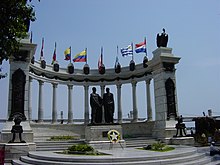
On the morning of October 9, 1820, Guayaquil declared itself the first part of today's Ecuador to be independent of Spanish colonial rule. Independence was achieved with almost no bloodshed, as the 1,500 soldiers of a reserve grenadier battalion and the civilian population of Guayaquil quickly defeated the royal guards and the Spanish authorities and captured them.
The city gave itself the status of a free province, which was ruled by José Joaquín de Olmedo as Jefe Civil . The Free Province of Guayaquil comprised the coastal region of Ecuador and coastal areas that are now part of southern Colombia and northern Peru .
In 1822 the two “liberators” Simón Bolívar (coming from the north) and José de San Martín (coming from the south) met in Guayaquil and signed a compromise on close state relations between the republics they founded. Guayaquil was then incorporated into Greater Colombia - without being explicitly consulted . Since the secession of Ecuador from Greater Colombia in 1830, it has belonged to Ecuador.
19th century
In the 19th century, Guayaquil was often the scene or starting point of military uprisings and coups:
The first took place in November 1830 and opposed the secession from Greater Colombia. It ended after Bolívar died. In 1833, after a month , the Vicente Rocafuertes uprising was crushed by the troops of President Juan José Flores . In 1835 Rocafuerte nevertheless became President of Ecuador. After the end of his presidency, Flores was again his successor and Rocafuerte governor of Guayaquil. His personal commitment to fighting a yellow fever epidemic in 1842, which claimed many lives, earned him recognition.
In 1845, Flores' second presidency ended after a revolt in Guayaquil, which was followed by a military campaign that overthrew Flores and brought a triumvirate of José Joaquín de Olmedo , Diego Noboa and Vicente Ramón Roca to power. These events went down in Ecuadorian history as the revolución marcista ( March Revolution ). A constituent assembly eventually elected Roca president.
On July 17, 1851, Generals José María Urbina and Francisco Robles arrested Noboa, who was now president, during a visit to Guayaquil, took him out of the country and proclaimed himself in power. During the civil war of the “National Crisis” of 1859/60, President Francisco Robles temporarily moved the country's seat of government to Guayaquil in order to be able to fend off a Peruvian invasion from there. When the initially external crisis developed into civil war, Guayaquil formed its own government under General Guillermo Franco , which worked together with Robles' government, which had since moved to Riobamba. In 1860, however, troops of the conservative Gabriel García Moreno advancing from Quito took Guayaquil (with the support of the old General Flores) and at least formally restored national unity under a central government formed by García Moreno.
In September 1876, after the assassination of García Moreno, the newly appointed commander in chief of the armed forces , General Ignacio de Veintimilla , rose up against his successor Antonio Borrero and declared himself dictator . At first he only stayed in power for a short time, then staged another coup in 1878 and ruled until he fled the country in 1883 when another civil war broke out.
In 1837 part of the diocese of Cuenca became the Catholic diocese of Guayaquil , which has been an archdiocese since 1956 .
Liberal revolution and export bourgeoisie
In 1895 the city of Guayaquil proclaimed Eloy Alfaro , who was also in exile as a result of the civil war of 1883/84, in which he was proclaimed head of state in the province of Manabí, as the country's supreme commander. Alfaro then returned from Panama to Ecuador and moved from the coast with troops to the Andean region. He succeeded in overthrowing the regular government of President Luis Cordero . Since he then severely curtailed the influence of the church and clergy and supported the efforts of the bourgeoisie in the coastal cities in particular towards an export-oriented capitalist economic policy, Alfaro's takeover went down in Ecuador's history as a liberal revolution .
In the context of increasing world demand, Alfaro's politics supported the second cocoa boom, which had made economic activity in Guayaquil gain momentum since the end of the 19th century. A new class of agricultural exporters developed, orientated towards Europe and shaped the cityscape with their wealth. Guayaquil gained its reputation as the "Pearl of the Pacific" during this time.
In 1896, a conflagration left almost half of the town, which at the time consisted mostly of wood and bamboo structures. The reconstruction in stone destroyed the colonial heritage and the houses of the export bourgeoisie to a large extent, but it meant a big step into the modern age and gave the city the flair of a big city for the first time with some elegant cement buildings.
20th century
The strong expansion of banana cultivation in the coastal region , especially since the Second World War , and a simultaneous phase of attempts at import-substituting industrialization strengthen Guayaquil's position as a commercial and industrial metropolis of Ecuador. Large working-class and poor neighborhoods are being formed through heavy immigration. The populist five-time President of Ecuador José María Velasco Ibarra had his greatest support here, although he came from Quito. Many other presidents of Ecuador in the 20th century came from Guayaquil, including Carlos Julio Arosemena Monroy , Jaime Roldós , León Febres Cordero , Abdalá Bucaram and Rafael Correa .
In July 2002 the Second South America Summit took place in Guayaquil .
Population development
From originally around 150 inhabitants, the population rose slowly but steadily to 2,000 (1600), 5,000 (1693), 11,000 (1734) and 15,000 (1820) due to pirate attacks, epidemics and fires.
Since around the 1830s, the population has increased sharply, mainly due to immigration. In 1860 it was around 35,000, before it grew again very quickly to over 80,000 (1899), 150,000 (1930), 200,000 (1944) as a result of the development of Guayaquil to the port of the expanding export economy of Ecuador (especially cocoa).
Since the 1950s, the population has grown by more than 100,000 people per decade. Since then, the population and the inhabited urban area have grown more than tenfold. The majority of the population is poor. Many live in quickly and unorganized settlements, but only slowly and in retrospect infrastructural developed areas, in Ecuador called invasiones marginal settlements . El Guasmo and Mapasingue are more centrally located poor areas.
On the outskirts of the city, several gated communities based on the example of Miami for wealthy citizens have emerged since the 1990s, especially in the suburb of Samborondón and on the main arterial road Vía a la Costa . The press has criticized the fact that the children who grew up here far from reality will be the country's elite in the future.
Economy and Infrastructure
Guayaquil is the most important port city of Ecuador, since the 19th century it has been the destination of international freighters who transport the main export goods of the country, bananas , cocoa and coffee , today also shrimps ( prawns ) all over the world. Ecuadorian oil , on the other hand, is hardly exported via Guayaquil. In the past, the ships docked directly at the harbor embankment, the Malecón, at the height of the city center. Since 1963 there has been a modern port about ten kilometers south of it.
In addition to the import and export trade, Guayaquil is also an important financial center in Ecuador, although it has suffered over the past ten years from the collapse of two major banks. An important branch of industry is fish processing, especially the production of fish meal and canned tuna in Posorja, which belongs to the canton . In addition, there are larger facilities for food and beverage manufacturers and other industries for domestic needs.
The longest bridge in Ecuador, the Bridge of National Unity , which is officially called Puente Rafael Mendoza Avilés , stretches from Guayaquil over the Guayas or Daule and Babahoyo to the city of Durán on the other side . It is 2,825 m long, 1,032 m from Guayaquil to the small peninsula of La Puntilla, which separates the Daule river from Babahoyo, and 1,793 m from this to Durán. From Durán the most important roads lead to Riobamba and Santo Domingo de los Colorados , which connect Guayaquil with the Sierra , the Ecuadorian Andes .
Until a few years ago (since 1908) the train station in Durán was also used by daily trains to Quito, which are currently only used for tourism purposes. When President Rafael Correa took office, the complete renovation of the rail network began. This was completed in 2013. Guayaquil has had an airport since 1963, which was reopened as Aeropuerto José Joaquín de Olmedo in 2006 after extensive renovations , and since 1984 a modern bus terminal that has replaced the old train station in its importance.
Guayaquil is the seat of numerous universities , including the state Universidad de Guayaquil , the ecclesiastical Universidad Católica Santiago de Guayaquil and various privately owned universities, u. a. the Escuela Superior Politécnica del Litoral (ESPOL) and the Universidad Laica Vicente Rocafuerte .
Attractions
Malecón 2000, Cerro Santa Ana, Las Peñas
The wealth of the city, accessible to at least some, has led in recent years to the expansion and remodeling of parts of the center into an ensemble of restored colonial and republican buildings from the 19th century and modern architecture. Since 1998 the foundation Fundación Malecón 2000 , founded by the then mayor León Febres Cordero and continued by his successor Jaime Nebot , has undertaken the rehabilitation of the historic city center of Guayaquil. In particular, the former harbor embankment, which was expanded into the Malecón 2000 waterfront , and the adjacent hilltop Cerro Santa Ana have been transformed into attractive recreational and strolling areas through extensive construction and renovation measures, which attract national and international tourists. At the foot of the Cerro Santa Ana lies the Barrio Las Peñas , which has also been restored and has a colonial ambience with its wooden buildings , where the city has its historical origins.
Museums
On Malecón 2000 near the Barrio Las Peñas is the MAAC - Museo Antropológico y de Arte Contemporáneo, a museum for anthropology and modern art run by the Ecuadorian central bank. In addition to parts of the central bank's very extensive collection of pre-Columbian art, works by contemporary Ecuadorian artists such as Enrique Tábara , Manuel Rendón Seminario or Félix Arauz are shown here in changing exhibitions . In addition, the MAAC houses a cinema that is run as a program cinema and is also used for theater performances and concerts.
A modern museum, the Museo Nahim Isaías , located at the back of the city administration near the Malecón 2000, offers changing art exhibitions as well as a permanent collection of mainly pre-Columbian objects and sacred art from the colonial era. The City Museum of Guayaquil ( Museo Municipal de Guayaquil ) in the building of the city library presents changing exhibitions (including the winners of the Salón de Julio art prize ) and the history of the city.
The Parque Histórico opened in 2003 in Samborondón on Guayaquil on the opposite bank of the Daule river gives an insight into the cultural and natural heritage of Guayaquil. On an area of 8 hectares, it connects a young mangrove forest with an ecological zoo (with native animals such as the tapir , the ocelot and many birds), a 19th century farm with cocoa planting and an ensemble of reconstructed buildings from Guayaquil around 1900, the " Malecón 1900 ".
Sports and leisure facilities
Guayaquil has several football stadiums, some of which can also be used for other sporting events:
- Estadio Monumental Isidro Romero Carbo , home of Barcelona SC Guayaquil club
- Estadio George Capwell , home of the CS Emelec association
- Estadio Modelo Alberto Spencer Herrera , multifunctional stadium; current venue u. a. of FC Rocafuerte
- Estadio Alejandro Ponce Noboa de Fertisa , home of Club 9 de Octubre and CD Paladín
and a horse racing track, El Buijo, in Samborondón . The Guayaquil Marathon takes place on the first Sunday in October . The Parque Samanes with 851 hectares the third largest park in South America and in addition to numerous football, tennis, basketball and volleyball fields, various walking and cycling or roller shoe trails, several ponds, one of which can be traveled with boats, an amphitheater for concerts and a forest reserve with zip lines , a climbing wall, and bicycle and hiking trails.
Nature reserves and recreation areas
In the west of Guayaquil, on the edge of the Parroquia Chongón (Vía a la Costa, km 25), the Parque El Lago is located around a 2.6 km² reservoir . The park has an area of 406 km² and includes a forest reserve (tropical dry forest ) and the valleys of the Chongón and Bedén rivers. The park is home to a wide variety of tropical plant and animal species, including birds. The reservoir is used to collect water from the Daule River to be used for irrigation on the adjacent Santa Elena Peninsula. Fishing is possible in it, especially cichlids ( tilapia ) can be found there. Water sports (rowing, canoeing), cycling and camping (should only take place in guarded areas) are popular activities for visitors.
Also to the west of Guayaquil, a little closer to the center (Vía a la Costa, km 16), is the Cerro Blanco forest reserve, where there are various designated nature trails. This 6078 hectare nature reserve is home to more than 220 different species of birds and more than 50 different mammals. Further forest reserves are in the city center near Cerro Paraíso, Cerro Colorado with the botanical garden, in the Samanes Park, Palo Santo, or on the outskirts of Bosqueira, Prosperina and Papagayo.
Nearby (Vía a la Costa, 17 km) is the Puerto Hondo nature reserve with four mangrove swamps that can be visited on a guided canoe tour. There is also a small promenade and swimming is possible.
There is a botanical garden in the city, which also houses animal enclosures.
Local Holidays
July 25th and October 9th are official holidays in Guayaquil, which are celebrated with parades and other ceremonies.
Events
Administrative structure
Guayaquil city
The city of Guayaquil is divided into the following parishes ( Parroquias ) on an area of 1,801 km² :
- Ayachucho (named after the Battle of Ayacucho in the South American Colonies' War of Independence, 1824)
- Bolívar (named after the libertador Simón Bolívar )
- Carbo (named after Pedro Carbo , a politician)
- Chongón (named after the Chongón-Colonche range of hills )
- Febrés Cordero (named after León de Febres Cordero , a liberation fighter and ancestor of one of the most influential families in Ecuador)
- García Moreno (named after President Gabriel García Moreno )
- Letamendi (named after Miguel Letamendi , independence fighter )
- Nueve de Octubre (named after October 9, Guayaquil's day of independence in 1820)
- Olmedo (named after the politician and first President of the Free Province of Guayaquil, José Joaquín de Olmedo )
- Pascuales, named after the patron saint of the local church, St. Paschal Baylon
- Roca (named after the ex-president Vicente Ramón Roca )
- Rocafuerte (named after the ex-president Vicente Rocafuerte )
- Sucre (named after the independence fighter Antonio José de Sucre )
- Tarqui (named after the Battle of the Tarqui River in which a Peruvian invasion was repulsed)
- Urdaneta (named after Luis Urdaneta , independence fighter)
- Ximena (named after Rafael Ximena , independence fighter )
Guayaquil Canton
The canton of Guayaquil covers an area of 6,212 km² in addition to the urban parishes listed above, the rural parishes of Juan Gómez Rendón ( Progreso ) in the west of the city, Posorja and El Morro in the southeast and Tenguel and Puná in the south. The parish of Puná includes Isla de Puná , the largest island in the Gulf of Guayaquil in the Pacific .
Town twinning
- Guayaquil maintains twinning relationships with Houston , Texas, USA.
- A friendship exists with the Italian city of Genoa .
sons and daughters of the town
- Francisco Xavier de Garaycoa (1775-1859), Roman Catholic bishop
- José Joaquín de Olmedo (1780–1847), politician, poet
- Vicente Rocafuerte (1783–1847), politician, second President of Ecuador (1834–39)
- Gabriel García Moreno (1821–1875), formative Ecuadorian politician in the 19th century
- Alfredo Baquerizo Moreno (1859–1951), politician and diplomat, President
- María Capovilla (1889–2006), eldest living person from 2004
- Frederick Ashton (1904–1988), ballet dancer and choreographer
- Alfredo Pareja Diezcanseco (1908–1993), writer and diplomat
- Pancho Segura (1921-2017), tennis player
- Enrique Tábara (* 1930), painter
- León Febres Cordero (1931–2008), entrepreneur and politician (President of Ecuador 1984–88, Mayor of Guayaquil 1992–2000)
- Julio Jaramillo (1935–1978), musician of the Pasillo
- Gustavo Noboa (* 1937), university professor and politician, President of Ecuador 2000–2003
- Alfredo Palacio (* 1939), cardiologist, President of Ecuador from April 20, 2005 to January 15, 2007
- Jaime Roldós (1940–1981), lawyer, university professor and politician (President 1979–81)
- Benjamin Urrutia (* 1950), poet and writer
- Abdalá Bucaram (* 1952), former mayor and president (1996/97)
- Alfredo Espinoza Mateus SDB (* 1958), Archbishop of Quito
- Andrés Gómez (* 1960), tennis player
- Mike Judge (born 1962), producer and voice actor ( Beavis and Butt-Head )
- Rafael Correa (* 1963), 2007–2017 President of Ecuador
- Marlon Ayoví (born 1971), football player
- Debbie Mucarsel-Powell (* 1971), American politician
- Ana Cecilia Blum (* 1972), author and journalist
- Giovanni Lapentti (* 1983), tennis player
- Christian Noboa (* 1985), football player
- Michael Arroyo (* 1987), football player
- Felipe Caicedo (* 1988), football player
- Roberto Quiroz (* 1992), tennis player
- Diego Hidalgo (* 1993), tennis player
- José Francisco Cevallos Enríquez (born 1995), football player
- Maribel Caicedo (* 1998), hurdler
- Leonardo Campana (* 2000), football player
Web links
- Official portal of the city (administration) Guayaquil (Spanish)
- Guayaquil - a city in flux - changes in the city from 2000 to 2004
Newspapers
- El Universo, the largest daily newspaper in Guayaquil
- El Telégrafo, another daily newspaper in Guayaquil
Universities
- Website of the Universidad de Guayaquil
- Website of the Universidad Católica de Santiago de Guayaquil
- Website of the Escuela Superior Politécnica del Litoral
Individual evidence
- ↑ Guayaquil en cifras ecuadorencifras.gob.ec. Retrieved August 17, 2018 (Spanish)
- ↑ website of the Mayor's Office of Guayaquil guayaquilmildestino.com. Accessed August 17, 2018 (Spanish)
- ↑ Guayaquil exploringecuador.com. Accessed August 17, 2018
- ↑ Conectar áreas naturales es el desafío de Guayaquil , Ricardo Zambrano, El Universo , July 23, 2017 (in Spanish)
- ^ Sister Cities. Retrieved October 24, 2017 .
- ↑ Genoa website
